What Do Bed Bugs Eat Other Than Blood?
There are two kinds of parasites: those that feed on their host’s skin or blood, and those that live near them, eating crumbs and anything similar that the host leaves behind. Cockroaches are the most obvious example that falls in the latter camp. But what about bed bugs?
Bed bugs have evolved to only eat blood from humans, but also from other mammals. Their mouth is like a straw. Bed bugs don’t have teeth or a tongue to chew with, so they can’t eat any other food.
Imagine if you had just a straw instead of a mouth—you would only eat soup and other similar, liquid foods. It’s the same for bed bugs, with no exceptions as to species. The exact same is true for Cimex adjunctus just as it is for Cimex lectularius and Cimex hemipterus.
Table of Contents:
Do Bed Bugs Only Feed on Blood?
Everybody knows that bed bugs feed on blood. But there are regular stories of bed bug infestations that survive for more than a year, even without a host. So, surely they’re eating something else? Let’s find out what bed bugs eat other than blood.
Bed bugs are renowned for being able to survive in the absence of a host for years at a time. If the house is empty, that means there aren’t any people or pets for them to feed on. There aren’t even any crumbs that they might be able to eat. So do bed bugs survive in these conditions by eating each other?
No, bed bugs don’t eat each other. This kind of behavior isn’t normal in any sort of population, because it decreases the number of individuals that are available to mate. Any species that regularly eats its own kind is likely to die out soon enough.
They don’t feed on ‘bed bug blood’, either. Insects don’t have blood like humans. According to Scientific American, they have a different fluid called ‘hemolpymh’, which is different in a few ways (it doesn’t contain hemoglobin, for example). And, obviously, they don’t have as much. This makes it unsuitable for bed bugs to eat. In fact, the bed bugs that feed on us can only feed on the blood of mammals.
Do Bed Bugs Eat Food Crumbs?
Many pests survive in people’s homes by eating from the trash, from food that’s left out, or just from crumbs that were brushed to the floor. The most obvious example is obviously the cockroach. A cockroach can live for months on nothing but tiny crumbs that you wouldn’t even notice—and heaven forbid that you leave some food out, because there’ll be a big group of them all over it.
Do bed bugs feed on crumbs too? No, they don’t. You can test it yourself. Leave some crumbs out on a plate in a heavily infested house and see if the bed bugs try to eat them. There might be some that clamber over the plate, but they won’t crowd there, and they won’t eat it.
Do Bed Bugs Eat Dead Skin?
You might already know that there are tiny insects that feed solely on dead skin. Dust mites, as they’re known, are small enough that you can’t see them with the naked eye. They live in carpets and around your house, feeding on dust (dead skin). So do bed bugs do the same to survive?
No, bed bugs don’t eat dead skin. While there are some parasites that do tend to eat dead skin and similar tiny crumbs, these insects specialize to be able to do that. Bed bugs are specialized in a different way: so that they can only eat blood. Their mouth is shaped a certain way so that it can only feed on blood; not anything that needs chewing before swallowing.
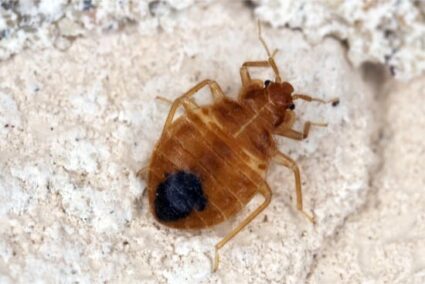
Do Bed Bugs Eat Your Hair?
People who have severe bed bug infestations complain that they get everywhere, including in your hair. Some are so worried that they think they can feel bed bugs in their hair throughout the day. This has a few implications: does it mean that they can live in your hair, or does it mean they can actually eat your hair?
No, bed bugs don’t eat hair. Their mouth is the wrong shape to be able to feed on hair. Besides, there aren’t any parasites that feed specifically on hair. Fleas and mites that live in hair feed on blood from your scalp, not the hair itself. It wouldn’t make sense for these parasites to eat hair, because if they did, they’d be eating their habitat. The only exception is cockroaches, which can feed on dead hair and skin.
Bed bugs find it difficult to crawl through skin and hair anyway, let alone eat hair. They much prefer finding open patches of skin to feed on rather than anything covered in hair. That’s why you’ll have far more bites along your back rather than on your scalp (unless your head is shaved).
Do Bed Bugs Eat Wood?
Since bed bugs live close by to their host, not on them, they can hide in any number of environments. This includes inside walls and inside furniture. Not only that, but other pests (cockroaches especially) can feed on things as varied as glue, paper, and dead insects. So, is it possible that they can feed on wood or other similar materials like plastic or metal?
No, they can’t. While bed bugs can hide in the cracks in furniture, or in the walls, they can’t eat wood. All they’ll do is hide as deeply as they can in any crack, especially on the underside of the furniture, and wait until they feel like feeding again. During this time, they’ll be completely inactive. They won’t move around, they won’t feed on you, and they won’t feed on the wood either.
Do Bed Bugs Eat Roaches (Or Other Insects?)
So, bed bugs don’t eat other bed bugs or feed on other bed bugs. But what about other insects? There are plenty of insects that eat other bugs, like cockroaches—which, according to the New York Times, eat bed bugs. But can bed bugs feed on roaches or some other kind of insect?
No, they can’t. Aside from the fact that they couldn’t survive on eating roaches (they need blood to survive), bed bugs also couldn’t get a roach to be still enough for long enough for them to feed. Bed bugs much prefer for their host to be still, which is why they wait until you’re asleep. If you move, like when you roll over in the night, they’ll scatter. You can imagine how difficult it would be for a bed bug to feed on a roach.
If you didn’t know, bed bugs evolved from ‘bat bugs’. When humans started living in caves, some bed bugs discovered that we were actually easier to feed on and had more ‘food’ in us than bats do. They came with us when we started living in houses instead. Today’s bed bugs are basically the same as bat bugs. Bed bugs can only feed on mammals like humans, not insects.
What Do Bed Bugs Eat and Drink?
Animals often need to drink as well as eat. Obviously, we do—and so do other mammals like cats, dogs and similar. So what about bed bugs, do they need to drink regularly as well as eating?
They don’t, because they get more than enough fluid from your blood. Bed bugs are actually experts at holding onto moisture, because they have an external waxy layer to their shell that stops any moisture from evaporating from their shell.
And as for what they eat, there’s only one answer. Rather than list any more things that bed bugs don’t eat, let’s be clear: bed bugs only eat blood. Bed bugs are ‘hematophagous’, which means that they eat only blood. If you didn’t know, blood is actually highly rich in nutrients, proteins, and fats, which make it the perfect food for small insects that would prefer to feed infrequently. Other hematophagous insects include mosquitos, vampire bats and certain kinds of butterfly.
The fact that blood is so rich in nutrients means that they can live for a long time without feeding.
How Long Can Bed Bugs Live Without Feeding?
Bed bugs are renowned for being able to survive even when there’s no host around. And given that we’ve established that they don’t eat anything other than blood, that means they must be able to survive with no food for an exceptionally long time. But how long?
Bed bugs can survive in the absence of a host for a year or more. During this time, they don’t eat or drink anything to get by—they just wait. They can live for so long for two reasons. First, they’re excellent at conserving moisture at most temperatures. The waxy outer lining of their shell stops moisture from getting in or out, like the lining of a windbreaker. And being insects, they don’t need much water in their system as it is.
They can also survive for long periods without food because they use most of the nutritional content of their ‘meals’ to grow rather than just to survive. Bed bugs feed before they grow from one life stage (also known as an instar) to another. Between meals, they digest and wait. Once they’re fully grown, they’ll need to feed less often as there’s less need for nutrients.
Why do Bed Bugs Only Eat Blood?
So, bed bugs can only eat blood. But why? It would be exceptionally convenient for them to be able to feed on other things. They would be able to survive long periods without a host, for a start.
Bed Bugs Evolved from Bat Bugs
Bed bugs evolved from what we call ‘bat bugs’. These are insects in the same genus (Cimex) as bed bugs. They’re basically the exact same as bed bugs, except they live in caves and feed on bats instead of people. Many thousands of years ago, when humans first started living in caves, these bat bugs discovered that humans were much better to feed on than bats:
- We have more blood in us than bats do, so we can support bigger populations of bed bugs than bats can
- We aren’t as hairy or furry as bats are, so they find it easier to bite us
- We’re very still at night while we sleep—much more still than bats are
- We don’t preen ourselves as much as bats do, and we don’t eat insects like bats do either
Because we were so perfect for these bat bugs, they started feeding on us more. The original bat bugs, as well as the ones that still exist today, need bat blood in order to reproduce. This was originally the way it was for the first human bed bugs, too. But over time they lost that need, and can reproduce after feeding on human blood too. That’s the only difference, though: even a skilled entomologist (insect scientist) can’t tell them apart just by looking at them.
So, what’s the point of all this? Well, all of this is to say that bed bugs evolved from an older species which has always eaten blood, too. There’s no other food in caves for the bat bugs to eat—they live solely on blood. Bed bugs haven’t felt the need to learn how to eat anything else ever since then.
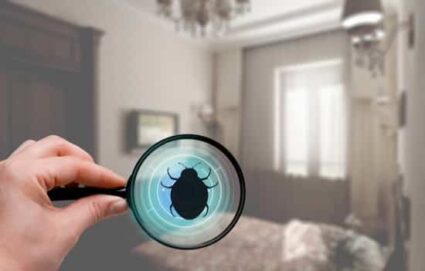
Bed Bug Mouth Parts
Bed bugs don’t have lips, teeth, cheeks or a tongue. They have what looks like a long beak or snout at the tip of their head; it’s as long as a leg, so to keep it out of the way, they fold it underneath themselves. They also have another, shorter tube right next to the longer one. The long beak is for sucking the blood, and the short one is for them to inject anesthetic saliva into the bite area.
Needless to say, this means they can’t chew or eat anything else. Imagine if we didn’t have any teeth, a tongue, or even lips: how difficult would it be to eat? And to make matters more complicated, instead of having a big opening for a mouth like we do now, what if we just had a straw? When you think of it that way, it’s obvious why they only eat blood.
How Do Bed Bugs Eat?
First, they’ll make a small incision. They’ll then simultaneously insert both of the tubes into your skin: the short one to stop it from hurting and itching, and the long one to find a capillary. They’ll move the longer tube around to try and find a capillary, and they’ll start sucking up your blood.
Feeding normally takes between ten and twenty minutes. If at any point you move or try and brush them away in your sleep, they’ll quickly scatter to get away from you. Unlike fleas and cockroaches, bed bugs are easy to squash and kill, so they’re more careful than other parasites. If they feed successfully, they’ll become two to three times their previous size because they’re filled with blood.
After they eat, they’ll head back to their hiding place to digest, and if necessary, grow to their next life stage. Because their feeding tube is very thin, the incision they make heals quickly.
But the saliva they leave behind to stop the wound itching wears off eventually, because your body recognizes it and gets rid of it. This is what causes the allergic reaction to bed bug bites, i.e. the raised, itchy bumps you get from one.
How Often Must Bed Bugs Eat?
How long does it take for bed bugs to die without a host? Bed bugs can survive for a year or more without feeding on a host. So, in one way, you could say that bed bugs must feed at least once a year. However, they will feed much more frequently than this if they have access to a host. Most bed bugs will eat every five to ten days as they grow, as they continue to breed and grow the infestation.
Once fully grown, bed bugs don’t need blood in order to get to their next life stage, so they slow down—but just a little. They still need nutrients in order to mate and produce eggs, which will take up most of their time when they’re adults. Once every ten days to two weeks is normal.
Bed bugs are also known to increase the frequency of their feeds during warmer months. This is because the warmer weather aids their digestion, meaning that they can grow to their next stage more quickly. Once at their next stage, they then need to feed again. In these warm conditions, a bed bug may feed just once every two or three days. The reverse is true during the colder seasons, when bed bugs may only feed once every month.
What Do Bed Bugs Eat?
If you wake up in the morning and feel itchy in areas such as your hands, ankles, neck, face, arms, or abdomen, and you notice that the bites do not have a red spot on the center like most insect bites, then you might be having a bed bug infestation. Bed bugs are tiny (about 7 millimeters) insects that live along cracks and crevices inside homes. Like most bugs and fleas, they bite, but their bite is far itchier than the others, and they are obviously much harder to remove.
If you’re currently battling an infestation, please visit this complete guide for how to get rid of bed bugs and consider the #1 option for bed bug removal, linked below.

- USDA BioBased formula is child and pet friendly
- 100% effective per recent study
- Kills bed bugs at all stages – adults, nymphs, and eggs
Bed bugs are notoriously difficult to get rid of once they have started infesting an area. Most bed bug treatments are done with professional help especially when the infestation is bad. And what makes it worse is that bed bugs can also easily be carried through infested mattresses or even on comforters and pillows that are left unchecked. Most people believe that bed bugs can appear due to poor hygiene, but this isn’t exactly the case.
Bed bugs can appear randomly on any home when they hitch rides on furniture, clothing, backpacks, or even suitcases. Bed bugs bite humans in their sleep to suck blood, but what other food do bed bugs like to eat?
What Do Bed Bugs Eat?
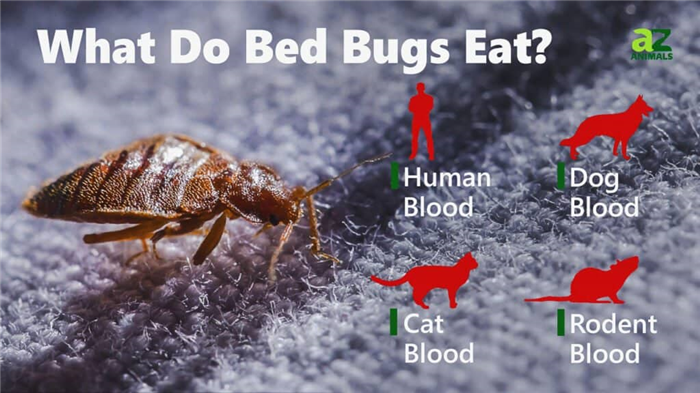
Bed bugs are known to actively and directly suck blood from their hosts’ bodies.
Bed bugs are well-known to eat human blood, thus the notorious bed bug bites. However, bed bugs also feed on other warm-blooded animals such as cats, dogs, rodents, birds, and even bats.
Parasites can fall into two categories –those who actively and directly suck nutrients from their hosts’ bodies, and those who feed on their hosts’ leftovers. Cockroaches are a great example of the second type of parasite. Bed bugs, however, fall under the first category without a doubt.
There are around 90 species of bed bugs on the planet. All of these species love the taste of blood and depend on it to live, yet fortunately for us, only three of them prefer sucking human blood. The rest of the species prefer the blood of other mammals such as bats. For some species, specific mammal blood helps them lay healthy eggs. There are species of bed bugs who will feast on any type of blood though, depending on what is easily available to them.
How Do Bed Bugs Eat?
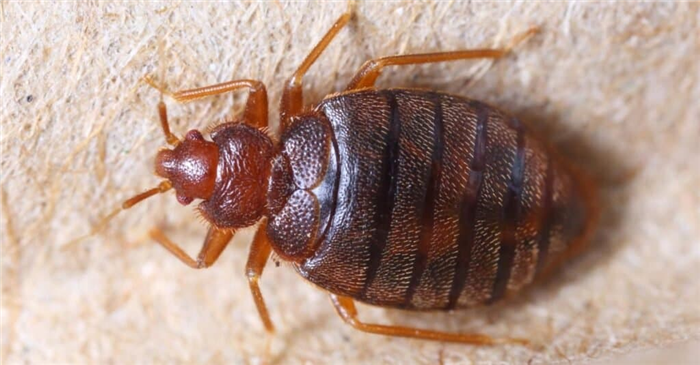
With the help of their straw-like suckers, bed bugs suck blood from their hosts.
7th Son Studio/Shutterstock.com
Bed bugs do not have mouths. They have straw-like suckers to help them suck blood from their hosts. Bed bugs also do not have any tongue or teeth to chew food, so the only choice they have for food is blood. They are equipped with a sharp and elongated beak or proboscis which they insert into the human or mammal’s skin. They feed on their hosts for about 10 minutes, and the amount of blood taken in such feeding is enough to last them for days.
These wingless insects are naturally reddish-brown in color with short, golden hairs, but as they fill themselves with blood, their bodies become redder and redder.
What Do Different Types of Bed Bugs Eat?
Of the 90 different types of bed bugs around, only three of them prefer human blood. However, that doesn’t mean that the remaining 87 species won’t touch blood. All bed bugs have the same mouth anatomy, which means all bed bugs feed only on blood. The only difference in their preferences is the host they love to feed on.
The three species of bed bugs that typically infest homes and feed on human blood are Cimex lectularius, which are the common bed bugs, Cimex hemipterus, which are the tropical bed bugs, and Leptocimex boueti.
As a European or American resident, you need to be careful about C. lectularius and C. hemipterus. For these species, human blood is the main energy source, and what’s more frightening is that they like to live in carpets, sofas, mattresses, or even behind heavy furniture and wallpapers. As they live inside houses, feed on human blood, and get necessary nutrients from their hosts’ bodies, they are able to mate, breed, and lay eggs.
L. boueti, on the other hand, can be found in South American and West African regions. L. boueti might feed on people, but they are more interested in the blood of bats. So these bugs are mostly seen in residential areas where bat populations are within proximity.
Do Bed Bugs Eat Each Other?
There are bed bugs who survive in abandoned houses for years, which means they wouldn’t have any host to feed on. But that doesn’t mean that bed bugs feed on each other. Since the populations of bed bugs are not decreasing, it is a sign that these creepy crawlies are not cannibals, because if they are, they will be placing their mating numbers in jeopardy and their species might eventually die out.
Contrary to what many people assume, bed bugs do not suck insect blood as well. In fact, insects do not have blood, they are filled with a liquid component called hemolymph that circulates throughout their body.
Are Bed Bug Bites Harmful to Humans?
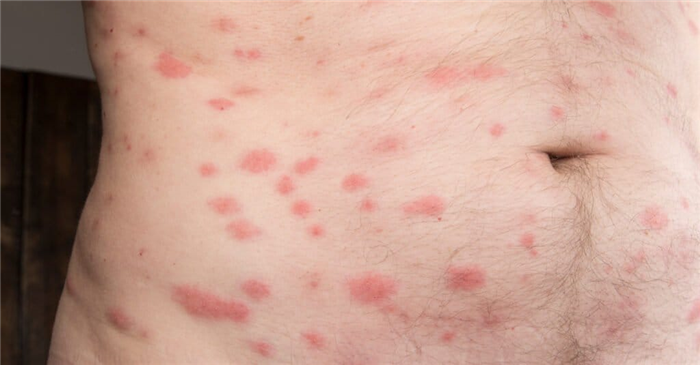
Bed bug bites sometimes cause allergic reactions which in turn may cause hives and severe itching.
Unlike mosquitoes who spread deadly diseases, the only harmful effects of bed bug bites are continuous itching and sometimes allergic reactions which may cause fever, hives, blisters, or severe itching. Worse, bed bug bites can sometimes cause some psychological concerns like insomnia and anxiety, and may also lead to bacterial infections such as ecthyma, impetigo, and lymphangitis.
Although feeding takes an average of 10 minutes, bed bug bites are initially painless due to an anesthetic they inject in the host’s skin during feeding. Feeding takes place for as short as four minutes and can last for a maximum of 12 minutes. Bed bug bites may appear like a red swollen bump about a centimeter wide and are mostly patterned in a zigzag. This is because bed bugs intentionally take numerous bites in search of large blood vessels just beneath the skin of their hosts.
What Eats Bed Bugs? What is a Natural Predator of Bed Bugs? [Videos]
If you are wondering what eats bed bugs we can help you with an answer! There are a few insects that eat bed bugs. Bed bugs are in the class of insects called “true bugs”, Hemiptera. For reference, other insects in this group are cicadas, stink bugs, water bugs, as well as many more.
What sets true bugs apart from other insects is that they go through a type of metamorphosis. All true bugs hatch as a nymph from the egg.
In fact, a nymph is a miniature version of the adult bug. Bed bugs do not have a larval stage. Our aim is to help you learn everything about bed bugs.
Using a bed bug mattress protector can help you monitor for bed bugs while minimizing any hiding places around your mattress or box spring.
Finding a predator for bed bugs is not necessarily a good strategy for bed bug mitigation. Your home would then become overrun with the insect or animal that is eating the bed bug. Therefore biological control of bed bugs via predators is not a sound pest control method.
If you want to see photos and videos of bed bugs in action check out Lou Sorkin’s website. He is an entomologist and has documented and studied bed bug for years.
Whether you want to find out what eats bed bugs or are just looking for something to trap and monitor bed bugs you have come to the right place. These black bed bug traps can help. According to research bed bugs gravitate towards the colors black and red, so I would buy the black ones instead of the white.
**Amazon disclosure: this site will earn a few pennies for our scholarship fund, if you purchase through the Amazon link**

If you are still curious as to what eats bed bugs: here is our list!
The larvae of the moth identified as Pyr’alis pictalis (Pyralidae: Lepidoptera), eats bed bug eggs. This moth larvae can infest stored food products such as tapioca and other starchy foods. In fact, a scientific investigation in India over 50 years ago showed that these larvae devoured the eggs of bed bugs readily.
Although the larvae did not eat the bed bug nymphal stages. This study by Wattal, B. L.; Kalra, N. L. Titled Pyralis pictalis Curt. (Pyralidac: Lepidoptera) Larvae as Predators of Eggs of Bed Bug, Cimex hemipterus Fab. (Cimicidae: Hemiptera) found that bed bugs were increasing in numbers when pesticides killed off the moth larvae. This then led to scientific research which confirmed that the moth larvae are natural bed bug predators.
DO SPIDERS EAT BED BUGS?
Spiders will definitely eat bed bugs if given the opportunity. Additionally, not all species of spiders will catch and devour bed bugs.
During my bed bug inspections, I often find a spider web underneath a client’s box spring. Over the past 8 years, I have seen about 7 bed bugs caught in a spider’s web.
If there is an active bed bug infestation then a spider being a natural predator of bed bugs will catch a few bed bugs for a meal. Although spiders will never be able to catch enough bed bugs to reduce the population.
DO ANTS EAT BED BUGS?
Pharaoh ants are a hassle for any person dealing with them. The pharaoh ants are much smaller than an adult bed bug, they are only 2mm long. Since they build their nests in hard-to-reach places, like floorboards and wall voids, they may be difficult to eradicate.
If disturbed, they will quickly split off from their colony and start new ones elsewhere. However, they actively consume bed bugs.
A pharaoh ant is just one of many types of ants that feed on bed bugs. Bed bug natural predators are these ants.
Therefore, ants do eat bed bugs, here is a video showing fire ants eating a bed bug.
Fire Ants will actively hunt and kill a live bed bug. Adding fire ants to your home is definitely not a good bed bug solution. I found this video on YouTube of a bed bug released near a fire ant colony. As you can see the ants all come out to attack and kill the bed bug.
WHAT ARE THE NATURAL ENEMIES TO BED BUGS?
The Masked Bed Bug Hunter is nocturnal and will feed on any number of insects. A few of these include bed bugs, carpet beetles, and bat bugs. According to the PENN state entomology department, one unique behavior of these bugs is that they camouflage themselves with dirt and dust.
They do this by placing the dirt and dust on their bodies with a glue-like substance. Unfortunately, the masked bed bug hunter can cause a painful bite on humans and pets. Keeping that in mind that what eats bed bugs might not be good for eradication.
DO ROACHES EAT BED BUGS?
The cockroaches are excellent at eating bed bugs. During high bed bug populations, cockroaches are not able to make a difference because the bed bugs reproduce too rapidly. Additionally, you don’t want your home infested with cockroaches.
Roaches are naturally attracted to food crumbs, bugs, and dirt. Recently we went to a client’s apartment and found cockroaches feasting on baby bed bugs in her bed.
In addition, roaches spread disease. Cockroach feces and saliva contain a variety of allergens. Therefore, this is not a pest you want to bring into your home to control bed bugs.
If you see a lot of cockroaches around your bed, you may want to get a bed bug inspection. Insects that eat bed bugs include roaches.
Learn about what roaches eat here. Plus if you want to get really disturbed just watch this video of a cockroach eating a bed bug. What eats bed bugs? Roaches do, for sure!
DO CENTIPEDES EAT BED BUGS?
House Centipedes Many entomologists and pest control professionals say that you should never kill a house centipede. The reason being is that they travel all over your home devouring insects. House centipedes eat bed bugs, roaches, termites, moths, and many other unwanted pests.
You definitely do not want to release hundreds of house centipedes into your home in order for them to kill the bed bugs. On the other hand, if you see a few house centipedes every so often, I would just leave them alone.
They are working behind the scenes to keep your house pest-free! If you often experience bed bug anxiety get one of the bed bug heaters, it will allow you to throw your backpack and clothing into it, anytime you go somewhere that feels suspicious.
In conclusion, there are many insects that might make a meal out of a bed bug. On the other hand, there aren’t any known mammals that are natural predators of bed bugs. Throughout the years I have heard anecdotal stories about people’s cats and dogs hunting bed bugs.
Clients have told me they saw their cat swatting at a bug that they later identified as a bed bug. There aren’t any scientific studies done that confirm this, so take this with a grain of salt. Insects found in your home can eat a few bed bugs here and there.
Alternatively, the use of bed bug predators is not a good way to eradicate bed bugs. Instead, get a steamer for bed bugs as well as hire a professional.
What Do Bed Bugs Eat? Do They Only Feed On Humans?
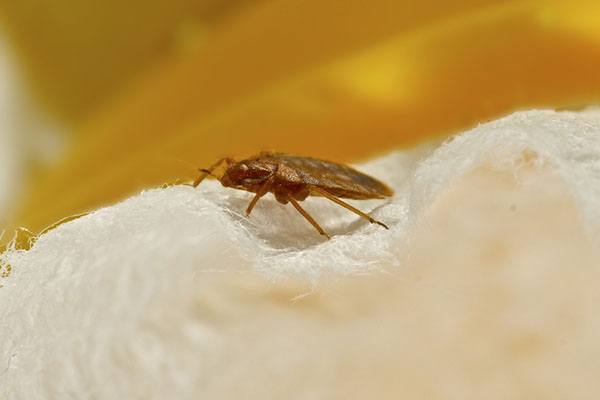
Bed bugs. You want them gone. They want to take over your home – and your bed. They do that well, staying hidden by day and preying on you at night while you are defenseless. This works for them and keeps them out of trouble with their human blood donors. But what do bed bugs eat besides blood?
There are many species of bed bugs, and they all feed on blood. Most species prefer one mammal over another. For some, the blood of specific mammals is required for them to lay viable eggs and survive. Most bed bugs, however, will feed on any blood available to sustain themselves, if their preferred warm blood is not available.
The most common species of bed bug associated with people is formally named Cimex lectularius. Human blood is their primary energy source. We house them, feed their young and provide them with the nutritional elements they must have to breed and produce viable eggs.
Should bed bugs be found in your house, they will most likely be C. lectularius, but it is important to remember that there is a possibility of other species invading, such as bat bugs. Bat bugs are in the same family as bed bugs and formally named Cimex adjunctus. As their name indicates, bat bugs live with and feed mostly on bats. Like C. lectularius, they will feed and survive on the blood of other mammals, including humans, but they must have bat blood to reproduce.
It is very important to identify which Cimex species you have, because their habits and habitats are quite different. In a typical bed bug infestation, close to 70 percent of the bed bugs will be either on or very close to the bed area.
You may not realize you have a bat infestation until bat bugs are identified in your home. Bat bug infestations will usually be in the attic or wall voids where bats have been nesting. These hiding spots are in completely different locations than that of bed bugs. Control must include removal of the bats and the bat bugs.
What do bed bugs eat? They might snack on animals. They might have bat-tasting relatives. But in the end, the bed bug’s favorite thing to eat is your blood. It will probably take a professional pest management specialist to identify whether you are dealing with human bloodsuckers or their bat brethren. The primary identifier is the relationship between the length of the hairs on the pronotum and the size of the eyes. Don’t know what a pronotum is? Then save your time, and your blood – call a professional.
Fast facts on bedbugs
- Bedbugs are small wingless insects that feed on the blood of warm-blooded animals.
- Most bedbugs feed on their hosts while they are asleep.
- The peak time for feeding is between midnight and 5 am.
- Bites can be seen quickly but may take up to 14 days to become visible.
- Bed bugs need to feed regularly to reproduce, lay eggs and survive.
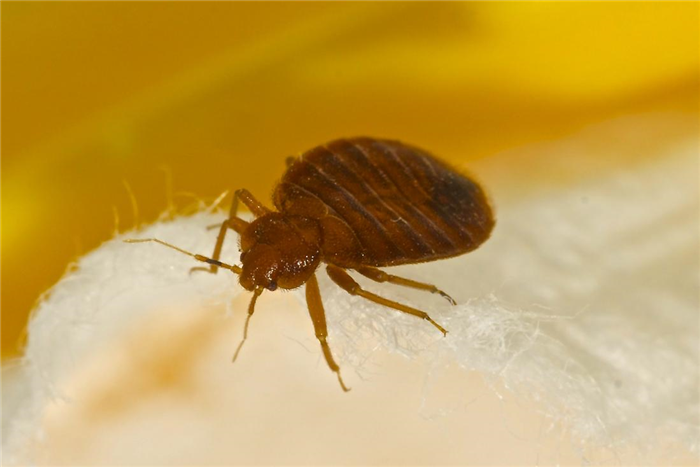
Share on Pinterest A bedbug may cause a coriander-like smell.
The most obvious sign of bedbugs in the home is that people complain of bites that occurred while they were asleep. If this happens, examine the bedrooms for bedbugs and signs of bedbug activity.
Look carefully in bed linen and the seams and tufts of mattresses and box springs for bugs or eggs. The eggs will look like tiny, pale poppy seeds.
Signs of bedbug activity may occur beneath loose areas of wallpaper near beds, in the corner of desks and dressers, in the laundry, and in drawers.
Keep an eye out for dark brown or rust-colored bedbug droppings that stain material and mattresses. Bedbug excrement is a liquid that looks either light brown or black, and it usually either beads up or is absorbed by the material around it.
